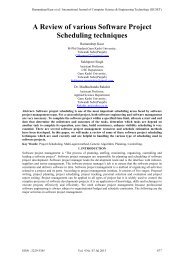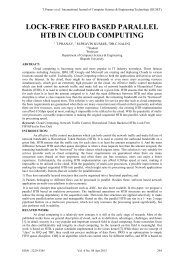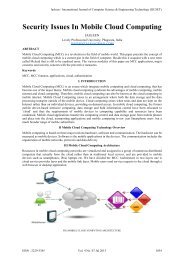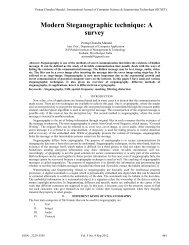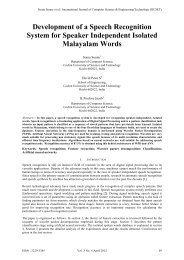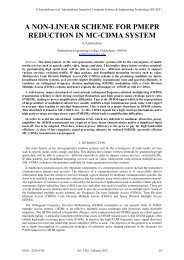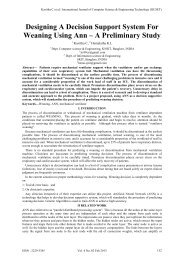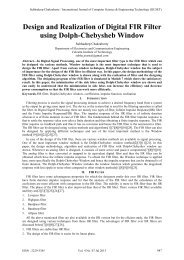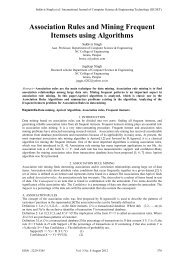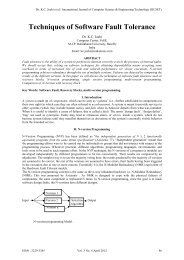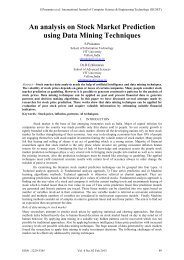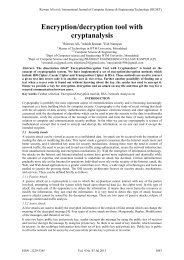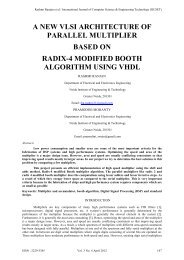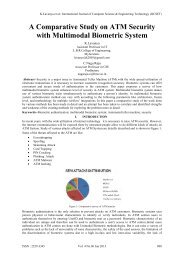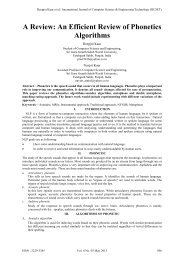Effect of Different Modulation on PAPR and Its Reduction - IJCSET
Effect of Different Modulation on PAPR and Its Reduction - IJCSET
Effect of Different Modulation on PAPR and Its Reduction - IJCSET
Create successful ePaper yourself
Turn your PDF publications into a flip-book with our unique Google optimized e-Paper software.
Ritesh Baranwal et al./ Internati<strong>on</strong>al Journal <str<strong>on</strong>g>of</str<strong>on</strong>g> Computer Science & Engineering Technology (<strong>IJCSET</strong>)<br />
IFFT<br />
SERIAL<br />
SELECT<br />
DATA<br />
SOURCE<br />
TO<br />
PARAL<br />
LEL<br />
CONV<br />
ERSIO<br />
N<br />
1<br />
2<br />
IFFT<br />
IFFT<br />
ONE WITH<br />
LOWEST<br />
<strong>PAPR</strong><br />
3<br />
1, 2, 3:- CARRIERSWISE PHASE (U) SEQUENCES<br />
Figure2: Block Diagram <str<strong>on</strong>g>of</str<strong>on</strong>g> OFDM Transmitter with the SLM Technique1<br />
IV.SELECTIVE MAPPING WITH PHASE ROTATION TECHNIQUE<br />
In SLM technique firstly [11], the input informati<strong>on</strong> is divided into OFDM data block Y, which c<strong>on</strong>sists <str<strong>on</strong>g>of</str<strong>on</strong>g> M<br />
symbols, by the serial-to parallel c<strong>on</strong>versi<strong>on</strong> <strong>and</strong> then data block Y is multiplied carrier wise with each <strong>on</strong>e <str<strong>on</strong>g>of</str<strong>on</strong>g><br />
the U different phase sequences<br />
, resulting in a set <str<strong>on</strong>g>of</str<strong>on</strong>g> U different OFDM data blocks<br />
= [ , , ]^T ------------------------- (4 )<br />
= . ‐‐‐‐‐‐‐‐‐‐‐‐‐‐‐‐‐‐‐‐‐‐‐‐‐‐‐‐‐‐ (5)<br />
m = 0, 1, · ·, M − 1, u = 1, 2, · · , U. Then all phase rotati<strong>on</strong> (U) alternative data blocks are transformed into time<br />
domain to get transmit OFDM symbol = IFFT { }.The informati<strong>on</strong> <strong>on</strong> the selected phase sequence must<br />
be transmitted to the receiver. All U phase rotated OFDM data blocks represented the same informati<strong>on</strong> as the<br />
unmodified OFDM data block Provided that the phase sequence is known [13]. After applying the selective<br />
mapping phase sequence, the complex envelope <str<strong>on</strong>g>of</str<strong>on</strong>g> the transmitted OFDM signal becomes<br />
y (t) = , 0 t MT -------------------------------(-6)-<br />
Here, MT is the durati<strong>on</strong> <str<strong>on</strong>g>of</str<strong>on</strong>g> an OFDM data block. Output data <str<strong>on</strong>g>of</str<strong>on</strong>g> the lowest <strong>PAPR</strong> is selected to transmit. Figure<br />
2 shows the block diagram <str<strong>on</strong>g>of</str<strong>on</strong>g> OFDM transmitter with Selective mapping phase rotati<strong>on</strong> technique. This<br />
technique effectively reduces Peak to Average Power Ratio without any signal distorti<strong>on</strong>. But the system<br />
become complex. This complexity can less by reducing the number <str<strong>on</strong>g>of</str<strong>on</strong>g> IFFT block [3, 4, <strong>and</strong> 5].Here IFFT block<br />
also maintain the orthog<strong>on</strong>ality <str<strong>on</strong>g>of</str<strong>on</strong>g> subcarriers.<br />
V. ALGORITHM FOR REDUCED <strong>PAPR</strong><br />
1. Generate data value <str<strong>on</strong>g>of</str<strong>on</strong>g> size Y = Y1, Y2, Y3…….YM.<br />
2. These data value are modulated using QPSK, DQPSK, <strong>and</strong> 4-QAM.<br />
3. These data value are given phase rotati<strong>on</strong> (U) from 1 to 4 degree. We get = .<br />
4. After giving phase rotati<strong>on</strong> we get signal = , , , ----------- .<br />
5. These frequency domain signal given to IFFT which c<strong>on</strong>vert it into time domain .The signal<br />
from each IFFT is orthog<strong>on</strong>al signals (subcarriers).<br />
ISSN : 2229-3345 Vol. 3 No. 8 August 2012 311



